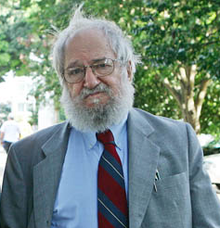
Constructionist learning is the creation by learners of mental models to understand the world around them. Constructionism advocates student-centered, discovery learning where students use what they already know to acquire more knowledge.[1] Students learn through participation in project-based learning where they make connections between different ideas and areas of knowledge facilitated by the teacher through coaching rather than using lectures or step-by-step guidance.[1] Further, constructionism holds that learning can happen most effectively when people are active in making tangible objects in the real world. In this sense, constructionism is connected with experiential learning and builds on Jean Piaget's epistemological theory of constructivism.[2]
Seymour Papert defined constructionism in a proposal to the National Science Foundation titled Constructionism: A New Opportunity for Elementary Science Education as follows:
The word constructionism is a mnemonic for two aspects of the theory of science education underlying this project. From constructivist theories of psychology we take a view of learning as a reconstruction rather than as a transmission of knowledge. Then we extend the idea of manipulative materials to the idea that learning is most effective when part of an activity the learner experiences as constructing a meaningful product.[3]
Some scholars have tried to describe constructionism as a "learning-by-making" formula but, as Seymour Papert and Idit Harel say at the start of Situating Constructionism, it should be considered "much richer and more multifaceted, and very much deeper in its implications than could be conveyed by any such formula."[4]
Papert's ideas became well known through the publication of his seminal book Mindstorms: Children, Computers, and Powerful Ideas (Basic Books, 1980). Papert described children creating programs in the Logo educational programming language. He likened their learning to living in a "mathland" where learning mathematical ideas is as natural as learning French while living in France.[4]
- ^ a b Alesandrini, K. & Larson, L. (2002). Teachers bridge to constructivism. The Clearing House, 119–121.
- ^ Cakir, M. (2008). Constructivist Approaches to Learning in Science and Their Implications for Science Pedagogy: A Literature Review. International Journal of Environmental & Science Education, 3(4), 193–206.
- ^ Sabelli, N. (2008). Constructionism: A New Opportunity for Elementary Science Education. DRL Division of Research on Learning in Formal and Informal Settings. pp. 193–206. Retrieved September 20, 2017.
- ^ a b Papert, S.; Harel, I (1991). "Constructionism". Ablex Publishing Corporation: 193–206. Retrieved September 20, 2017.
{{cite journal}}: Cite journal requires|journal=(help)